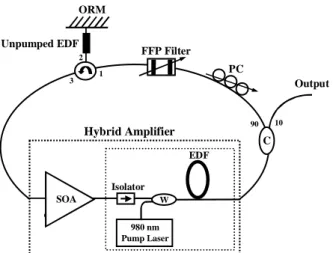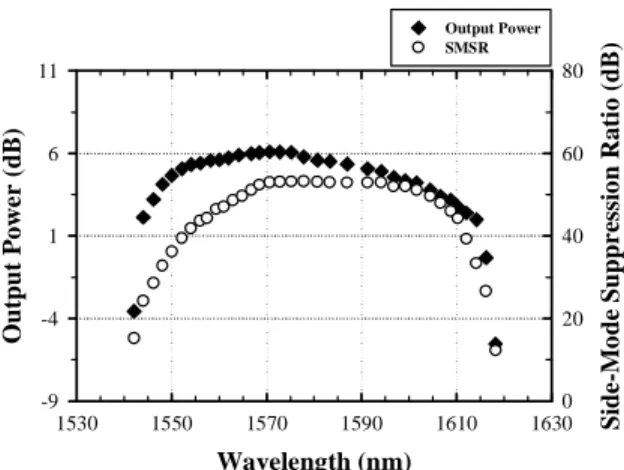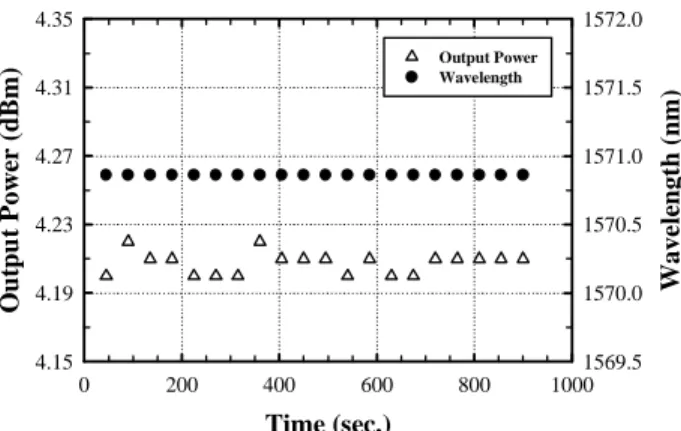A broadband fiber ring laser technique with
stable and tunable signal-frequency operation
Chien-Hung Yeh 1 and Sien Chi 2, 3
1 Transmission System Department, Computer & Communications Research Laboratories,
Industrial Technology Research Institute, Chutung, Hsinchu 310, Taiwan depew@itri.org.tw
2 Department of Photonics and Institute of Electro-Optical Engineering,
National Chiao Tung University, Hsinchu 300, Taiwan
3 Department of Electrical Engineering, Yuan Ze University, Chung-Li 320, Taiwan
Abstract:
A C- plus L-band fiber ring laser with wide wavelengthtunability and single-longitudinal-mode oscillation is proposed and demonstrated experimentally. A saturable-absorber-based autotracking filter, consisted of an unpumped erbium-doped fiber (EDF) and an optical reflected mirror (ORM), is employed to provide fine mode restriction and guarantee the single-frequency operation. Output power of > 2.1 dBm,
power stability of ≤ 0.02 dB, wavelength variation of ≤ 0.01 nm and
side-mode suppression ratio (SMSR) of > 31 dB / 0.05 nm have been experimentally demonstrated for this single-frequency fiber laser over an operating range of 1550 to 1608 nm.
©2005 Optical Society of America
OCIS codes: (060.2320) Fiber optics amplifiers and oscillators; (060.2340) Fiber optics components
References
1. C. C. Lee, Y. K. Chen, and S. K. Liaw, “Single-longitudinal-mode fiber laser with a passive multiple-ring cavity and its application for video transmission,” Opt. Lett. 23, 358–360 (1998).
2. J. Zhang, C. Y. Yue, G. W. Schinn, W. R. L. Clements, and J. W. Y. Lit, “Stable single-mode compound-ring erbium-doped fiber laser,” IEEE J. Lightwave Technol. 14, 104–109 (1996).
3. R. M. Sova, K. Chang-Seok, J. U. Kang, and J. B. Khurgin, “Tunable dual-/spl lambda/fiber ring laser based on 2/sup nd/order Sagnac-Lyot fiber filter,” in IEEE CLEO 2002 Tech. Dig. 1, 2002, pp. 444–445. 4. K. J. Vahala, P. Namkyoo, J. Dawson, and S. Sanders, “Tunable, single-frequency, erbium fiber ring
lasers,” in IEEE LEOS '93 Conf. Proc., 1993, pp. 708–709.
5. K. K. Chow, C. Shu, M. W. K. Mak, and H. K. Tsang, “Widely tunable wavelength converter using a double-ring fiber laser with a semiconductor optical amplifier,” IEEE Photonics Technol. Lett. 14, 1445– 1447 (2002).
6. A. Bellemare, J.-F. Lemieux, M. Tetu, and S. LaRochelle, “Erbiumdoped fiber ring lasers step-tunable to exact multiples of 100 GHz (ITUgrid using periodic filters,” in Proc. Eur. Conf. Optical Communications EOCC’98 1, 1998, pp. 153–154.
7. Y. Cheng, J. T. Kringlebotn, and D. N. Payne, “Stable single-frequency traveling- wave fiber loop laser with integral saturable-absorber-based tracking narrow-band filter,” Opt. Lett. 20, 875–877 (1995). 8. Y. W. Song, S. A. Havstad, D. Starodubov, Y. Xie, A. E. Willner, IEEE, and J. Feinberg, “40-nm-Wide
Tunable Fiber Ring Laser With Single-Mode Operation Using a Highly Stretchable FBG,” IEEE Photonics Technol. Lett. 13, 1167–1169 (2001).
9. S. Yamashita, and M. Nishihara, “Widely tunable erbium-doped fiber ring laser covering both C-band and L-band,” IEEE J. Sel. Top. Quantum Electron. 7, 41–43 (2001).
10. C. H. Yeh, C. C. Lee, C. Y. Chen, and S. Chi, “A Tunable C-plus-L Band Fiber Ring Laser Based on Hybrid Amplifier,” Jpn. J. App. Phys. 43, 650–651 (2004).
11. C. H. Yeh, C. C. Lee, and S. Chi, “A tunable S-band erbium-doped fiber ring laser,” IEEE Photonics Technol. Lett. 15, 1053–1054 (2003).
12. C. H. Yeh, K. H. Lai, Y. J. Huang, C. C. Lee, and S. Chi, “Hybrid L-Band Optical Fiber Amplifier Module with Erbium-Doped Fiber Amplifiers and Semiconductor Optical Amplifier,” Jpn. J. App. Phys. 43, 5357– 5358 (2004).
1. Introduction
Fiber lasers with stabilities and tunabilities are the key in wavelength-division-multiplexing (WDM) networks and sensor systems. Therefore, single-longitudinal-mode (SLM) operation in erbium-doped fiber (EDF) ring lasers is becoming all the more necessary. Conventionally, a fiber Fabry-Perot (FFP) filter can be used for wavelength tuning in a fiber ring laser. However, a FFP alone is insufficient to stabilize both the lasing wavelength and power of a fiber ring laser. Therefore, several other techniques providing single-frequency operation have been studied, such as using a passive multiple-ring cavity or a compound ring resonator composed of a dual-coupler fiber ring (DCFR) to guarantee SLM laser oscillation [1]-[3], integrating two cascaded FFP filters of wide different free spectral ranges (FSRs) into the cavity to provide full tunability and SLM operation [4], [5], adding an extra ITU-grid periodic filter in the optical loop [6], and using an unpumped EDF as a narrow bandwidth autotracking filter [7], [8]. Because of the bandwidth limitation of EDF, EDF ring lasers only can operate at C- (1530–1560 nm) or C- plus L-band [3], [10]. However, a novel S-band EDFA technique, which operated over the wavelength range from 1480 to 1520 nm, has also been reported [11]. To provide for a single-frequency fiber ring laser covering both C- and L-bands, we propose and experimentally demonstrate a stable and tunable single-frequency fiber ring laser based on a hybrid two-stage amplifier module and a saturable-absorber-based autotracking filter. The hybrid amplifier module is consists of a semiconductor optical amplifier (SOA) and an erbium-doped fiber amplifier (EDFA). A saturable-absorber-based autotracking filter is composed of an unpumped EDF and an optical reflected mirror (ORM) inside the ring cavity. The behavior and performance of the output power, wavelength stability, tuning range, and side-mode suppression ratio (SMSR) were studied.
2. Experiment setup
The experimental setup of the proposed C- plus L-band fiber ring laser with single-frequency output is illustrated in Fig. 1. This apparatus comprises a hybrid two-stage amplifier module, a
1×2 and 90:10 optical coupler (C), a FFP filter, an optical circulator (OC), a polarization
controller (PC), an unpumped EDF, and an ORM. For the hybrid amplifier, the first SOA stage was biased at 250 mA, and the second EDFA stage was composed of a high-concentration 18-m-long EDF (High Wave-742), a 1550/980 nm WDM coupler (W), an optical isolator and a 980 nm pump laser, as shown in Fig. 1. According to the proposed structure, we only employ an SOA and a shorter length of EDF, covering both the C- and L-band. Actually, the optical output of the SOA can be used to pump the second stage (EDFA module) and extend the operation bandwidth from C- to L-band.
The FFP filter is an all-fiber device having a widely tunable range, low insertion loss of < 0.5 dB, polarization-dependent loss (PDL) of ~ 0.1 dB, and a 3 dB bandwidth of 0.4 nm. The FFP filter with a free spectral range (FSR) of 80 nm and a finesse of 200 can provide the wavelength selection, when external voltage from 0 to 12 V is applied to the piezoelectric transducer (PZT) of the FFP filter. Single-longitudinal-mode oscillation can be realized by employing a FFP filter and a absorber-based autotracking filter [7]. The saturable-absorber-based autotracking filter consists of an unpumped EDF working as a saturable absorber and an ORM. The ORM used in the experimental setup has 99 % reflectivity. The ORM will reflect and interfere spatially propagating lightwaves in the saturated absorber. As a result, a spatial hole burning (SHB) effect is created in the saturated absorber and narrow-band filtering is provided [7], [8].
In addition, an optical spectrum analyzer (OSA) and a power meter (PM) are used to measure the output spectra and powers for the laser at the output port, as shown in Fig. 1. Furthermore, single-frequency performance is verified by using the delayed self-homodyne
980 nm Pump Laser W Isolator EDF Hybrid Amplifier SOA FFP Filter PC Output ORM Unpumped EDF C 90 10 1 2 3
Fig. 1. Experimental setup for the proposed stable and wavelength-tunable single-frequency fiber ring laser.
3. Results and discussion
Figure 2(a) shows the amplified spontaneous emission (ASE) spectra of the first SOA stage, second EDFA stage, and the hybrid amplifier when the EDFA and SOA were operated at 100 mW pump power and 250 mA bias current, respectively. When a hybrid amplifier is used, the medium gain can enhance and extend the operating range to longer wavelength [12]. The SOA is used to pump the second EDFA stage and extend significant gain into the L-band. The bias current of the SOA can be adjusted to control the cavity gain. From Fig. 2(a), an 80 nm ASE bandwidth of 1540 to 1620 nm of the hybrid amplifier can be discerned, and –19.3 dBm maximum peak output power occurs at 1566 nm. Figure 2(b) shows the output spectra of this proposed fiber laser in the wavelengths from 1542 to 1618 nm when a 1-m-long unpumped EDF is used. Wavelength (nm) 1500 1520 1540 1560 1580 1600 1620 1640 Powe r ( d Bm ) -50 -40 -30 -20 -10 Hybrid Amplifier SOA EDFA
-65 -50 -35 -20 -5 10 0 2 4 6 8 10 1560 1580 1600 1620 O u tp u t P o w er ( d B m ) V oltag e (V) Wav eleng th (n m)
(a) (b)
Fig. 2.(a) Optical spectra of the ASE for the hybrid amplifier, first SOA stage and second EDFA stage, respectively. (b) Output spectra of this proposed fiber laser over the wavelengths from 1542 to 1618 nm when 1-m-long unpumped EDF is used.
Wavelength (nm) 1530 1550 1570 1590 1610 1630 Output P o we r (dB ) -9 -4 1 6 11 Si de -M o d e Suppr essi o n Ra ti o (dB ) 0 20 40 60 80 Output Power SMSR
Fig. 3. The output power and SMSR of the proposed fiber ring laser versus tuning wavelengths in the operation range from 1542 to 1618 nm.
Figure 3 shows the output power and SMSR of this proposed fiber laser with a 1-m-long unpumped EDF over the operating range of 1542 to 1618 nm. As indicated in Fig. 3, the maximal output power of 5.7 dBm is achieved at near 1577 nm, while the output power drops to 3.7 and –0.32 dBm at 1604 and 1616 nm, respectively. The SMSR can be up to 53.2 dB/ 0.05 nm around 1577 nm. For lasing wavelengths from 1550 to 1608 nm, output powers are greater than 2.1 dBm and the SMSR can be maintained larger than 31 dB/ 0.05 nm.
Frequency (MHz) 0 20 40 60 80 100 -100 -80 -60 -40 -20 0 -100 -80 -60 -40 -20 0 Rela ti v e I n te ns it y No is e ( d B /H z) Conventional Proposed
Fig. 4. The self-homodyne spectra of the proposed and conventional ring lasers operated at 1570.25 nm.
To verify the single-frequency performance, the linewidth spectrum of this proposed fiber laser was observed by using the delayed self-homodyne technique. Figure 4 shows the self-homodyne spectra of the fiber laser with conventional structure [10] and the proposed fiber laser operated at 1570.25 nm. A noisy and unstable waveform with 3.3 MHz mode spacing spikes is observed in the spectrum of the conventional EDF ring laser. Contrarily, no
Time (sec.) 0 200 400 600 800 1000 Ou tp u t P o wer ( d Bm ) 4.15 4.19 4.23 4.27 4.31 4.35 W a v e le ng th (nm) 1569.5 1570.0 1570.5 1571.0 1571.5 1572.0 Output Power Wavelength
Fig. 5.The output power fluctuation (≤ 0.02 dB) and the wavelength variation (≤ 0.01 nm) of the single-frequency fiber ring laser at a wavelength of 1570.25 nm.
To further investigate the power and spectral behavior, the short-term stability of the proposed configuration is measured, as shown in Fig. 5. The lasing wavelength was 1570.25 nm and the observation period was over 900 seconds. Experimental results show that the proposed fiber laser has excellent stability. The proposed ring laser can dramatically reduce the wavelength variation to near zero. The output power fluctuation was less than 0.02 dB. Finally, over four-hours of observation, a stable output of the fiber ring laser was maintained.
4. Conclusion
We propose and demonstrate experimentally a novel technique for a fiber ring laser with wavelength tunability and single-longitudinal-mode oscillation, covering both the C- and L-bands. A saturable-absorber-based autotracking filter, consisted of an unpumped EDF and an ORM, is used to provide fine mode restriction and to guarantee single-frequency operation. An output power of > 2.1 dBm, power stability of ≤ 0.02 dB, wavelength variation of ≤ 0.01 nm, and SMSR of > 31 dB / 0.05 nm were experimentally demonstrated for this frequency fiber laser over a operating range of 1550 to 1608 nm. The proposed single-frequency fiber ring laser may be suitable for future WDM network applications.
Acknowledgments
This work was supported in part by the National Science Council (NSC) of Taiwan (R.O.C.) under grants NSC 93-2752-E009-009-PAE, NSC 115-004, and NSC 93-2215-E-115-005. Dr. C. H. Yeh’s email address is depew@itri.org.tw.


